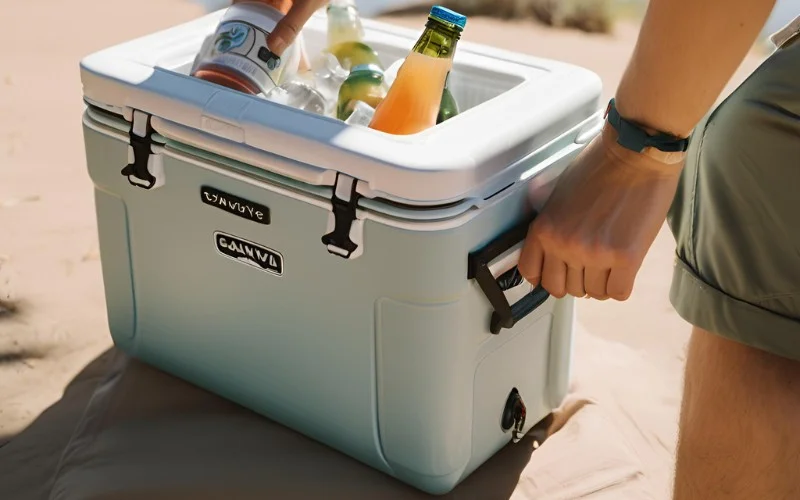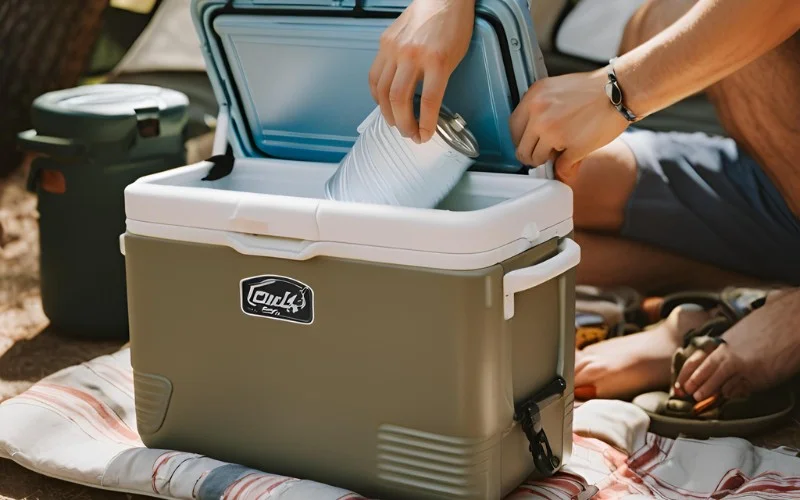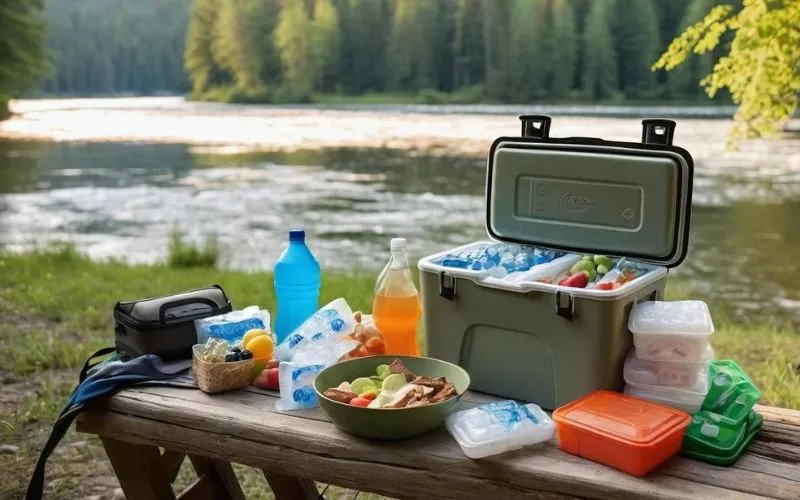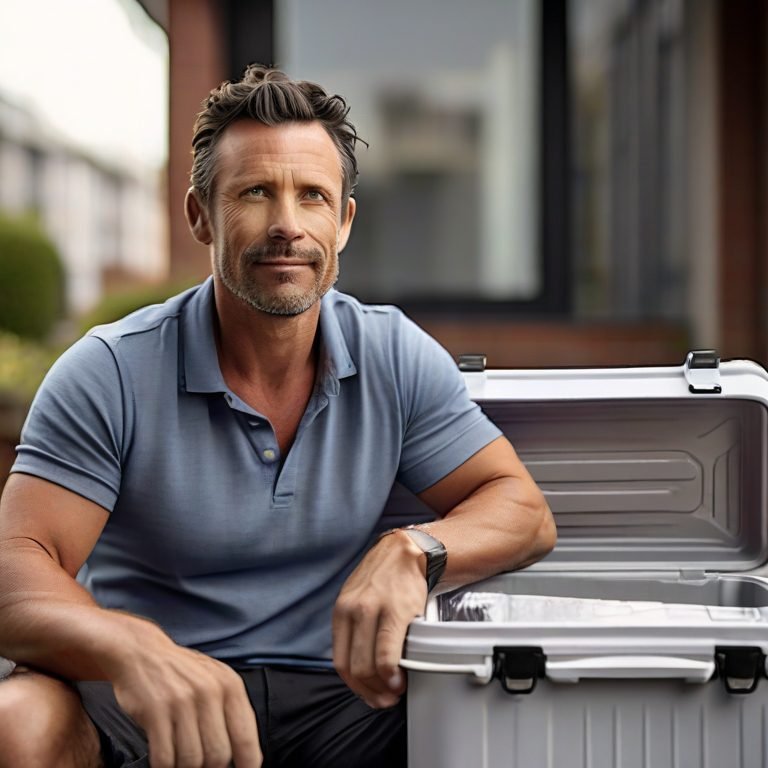Quality coolers offer an excellent solution for keeping food cold while camping. Designed with thick insulation and tightly sealed lids, they effectively lock in the chill for extended periods. Filling this cooler with ice the night before your camping trip can boost its cooling efficiency greatly.
When at your campsite, tuck the cooler away in the shade and limit how often it’s opened. This way, the frosty air stays put, keeping your edibles icy fresh. Now, picture your cooler as a tiny portable fridge you can take anywhere.
One effective way to keep food cold while camping is to pre-cool the cooler by putting ice in it the day before and draining the water before adding more ice. Additionally, frozen water bottles and gel packs to block heat from entering the cooler can help maintain lower temperatures.
Top Tips for Using a Cooler While Camping

When you’re out in the wild, keeping your food cold and safe to eat is essential for an enjoyable and risk-free camping experience. Here are some practical tips to make the most out of your cooler:
- Use a High-Performance Cooler: Investing in a high-performance cooler can significantly extend the time your food stays cold. These coolers typically have thick insulation and a good seal, which helps maintain colder temperatures for longer periods. Look for coolers specifically designed for outdoor activities, as they are built to withstand rugged conditions and provide better insulation.
- Pre-Chill the Cooler: Pre-chilling the cooler before you pack is a simple yet effective way to maximize its cooling capacity. Place ice inside the cooler the night before your trip to reduce its internal temperature. This ensures that your food stays colder for an extended period once you start using the cooler outdoors.
- Keep the Cooler in the Shade: The location of your cooler during your camping trip matters more than you may think. Placing the cooler in the shade helps prevent direct sunlight from warming up its contents, allowing it to retain cold temperatures more effectively. Additionally, avoiding frequent opening of the cooler also plays a crucial role in maintaining its coldness. When you open it, warm air enters and compromises the overall temperature.
These practical tips serve as valuable guidelines for maximizing the efficiency of your cooler during camping excursions. They ensure your food remains chilled and safe for consumption throughout outdoor adventures. Implementing these strategies ensures your camping trips are filled with delicious, safely stored meals. Now, let’s explore how to pack a cooler expertly for maximum cold retention.
How to Pack a Cooler for Maximum Cold Retention
Learning how to pack a cooler efficiently can make all the difference in keeping your food cold and safe during a camping trip. It’s not just about throwing everything in; how you organize and layer items can significantly impact how long your perishables stay chilled. Now, let’s delve into some effective techniques for optimal packing.
Step I – Pre-cool the Cooler
Before heading out on your adventure, ensure your cooler is pre-cooled to the desired temperature. Pre-cooling involves packing the cooler with ice the day before and draining the water before adding more ice. This ensures the cooler is at the ideal temperature to receive your food and drinks, maximizing your ice’s longevity.
Step II – Organize Items
Unorganized digging around in a cooler can lead to unnecessary exposure to warm air, so be mindful of how you arrange items. Organize food and drinks in separate areas within the cooler, grouped logically based on meal uses or time of consumption.
For example, having one section dedicated to breakfast items, another for lunch, and so forth helps limit the time the cooler lid remains open. This will reduce the chances of warmer air seeping in and affecting overall temperature.
Step III – Layering Technique
A strategic layering technique can substantially contribute to maintaining your foods’ coolness. Start by placing items that will be used last, such as raw meat, at the bottom of the cooler. Next, add pre-chilled foods and drinks, followed by a generous layer of ice.
Adopting this approach ensures that perishable items are insulated from direct contact with ice while still being suitably chilled. Now that we’ve covered key strategies for effectively packing your cooler, let’s look into additional tips for long-lasting cold retention during your camping trips.
Leveraging Your Vehicle Refrigerator for Food Storage
A vehicle refrigerator can be a game-changer when planning a camping trip, especially when driving to your location. These refrigerators are specifically built for use in vehicles, designed to run off your vehicle’s power and keep your food cold at a consistent, controlled temperature—eliminating the need to rely solely on ice and coolers that require constant replenishment.
It’s like having a mini fridge with you as you travel, providing a secure environment for all your perishable items without the limitations of conventional coolers. With the ability to maintain a consistently low-temperature range, typically from -8°C to 10°C, these refrigerators offer flexibility not possible with traditional cooling methods.
Advantages of Using a Vehicle Refrigerator
- Reliability: Unlike ice in traditional coolers, which melts over time, causing food temperatures to fluctuate, a vehicle refrigerator maintains a reliable and consistent temperature.
- Convenience: It saves you the hassle of constantly replenishing and managing ice levels in your cooler, allowing you to focus more on enjoying your camping experience.
- Control: You have greater control over the temperature settings, ensuring your food stays fresh and safe for consumption throughout your trip.
Imagine storing delicate items like dairy products or fresh produce without worrying about premature spoilage. Additionally, vehicle refrigerators often come with separate compartments or adjustable shelves, providing organization and easy access to food items.
It’s important to note that different vehicle refrigerators vary in size, capacity, and power consumption. For example, smaller models might consume around 0.5-2.5 amps of power, while larger ones could draw up to 5 amps.
When choosing a vehicle refrigerator, consider your power source—the 12V outlet in your car or the larger 24V outlet found in bigger vehicles like RVs—and ensure compatibility with your intended usage.
In the next section, we’ll explore some practical tips for maximizing the efficiency of your vehicle refrigerator and making the most of this modern camping convenience.
Utilizing Frozen Food and Cold Packs
When planning a camping trip, it’s not just about the journey or the destination but also the food you’ll carry along. Freezing foods that will be consumed later in the trip is a brilliant strategy to sustain freshness without relying heavily on constantly replenishing ice supplies.
Here’s the magic: By freezing your meat, veggies, and prepared meals before heading out, you can use them as natural cooling agents in your cooler. These frozen items can help maintain a consistently low temperature within the cooler for at least a day or two.
They also provide an additional source of refreshingly chilled water consumption as they thaw. For instance, freezing uncooked meats reduces bacterial growth during storage and keeps them safe for consumption for a longer duration during your camping trip.
Similarly, frozen water bottles serve a dual purpose—they act as ice packs to keep their contents cold and as a refreshing source of drinking water once they thaw.
Another bonus of using frozen foods is that they save packing space, eliminating the need to bring extra ice packs or large quantities of ice. This also means avoiding the hassle of melted ice turning your food soggy or creating a slush mess in the cooler.
Having explored the benefits of freezing food for camping trips, let’s explore how strategically incorporating these frozen items in your cooler can significantly enhance your overall camping experience.
Mastering the Art of Camping
Camping is all about fun, family, and fresh food, but keeping things cold in the great outdoors can be a challenge. Whether heading to the mountains or planning a backyard picnic, having the right gear and knowing how to use it is essential. There’s much to consider, from ice cubes to dry ice, coolers to thermal bags. Plan your menu, pack smart, and prioritize safety to ensure everyone enjoys delicious, cold food and drinks.
With some planning and the right gear, you can conquer any camping trip and keep your food tasting great, even in the most remote locations. Cross-contamination is a real risk, so separate raw and cooked food and clean everything thoroughly. With a little preparation, you can ensure your camping experience is filled with delicious meals and happy campers.
Alternative Techniques for Keeping Food Cold
Sometimes, you have to think outside the box to keep your food cool and safe when in nature. One old-fashioned but surprisingly effective method is to dig a hole, which can help maintain cooler temperatures for your food.
Digging a Hole
The ground insulates the cooler, especially if you dig down a bit. It’s like giving your cooler its natural home underground, where the earth’s cooler temperatures help counteract the day’s heat.
Pro tip: Line the hole with something waterproof, like a tarp or thick plastic, so moisture doesn’t seep into your cooler and spoil the food.
This technique can work wonders in hot climates or extended camping periods when keeping ice frozen becomes challenging. By leveraging the earth’s natural coolness, you may find that your food stays colder for longer, minimizing the risk of spoilage.
Reflective Sun Shades
Another clever strategy involves using reflective sun shades or blankets to cover the cooler. These shades help shield it from direct sunlight, preventing the contents from warming up too quickly.
Just as these sun shades keep parked cars cool in the summer, they can provide much-needed shade and heat deflection for your cooler when camping. It’s like making a mini camping tent for your cooler! The reflective material bounces sunlight away and helps maintain lower temperatures inside.
This method may be particularly valuable during scorching summer days when even the most insulated coolers struggle to stay frosty. By harnessing the power of reflection, you can keep your food and drinks as chilly as possible.
Employing these alternative techniques can extend the lifespan of your ice and ensure that perishable items remain safe to consume throughout your camping trip. As we explore ways to keep food fresh in the great outdoors, let’s consider options for preserving food without relying on a traditional cooler.
Options for Keeping Food Cold Without a Cooler
Sometimes, you might find yourself without a cooler when camping, but that doesn’t mean your food has to suffer. There are several creative solutions to keep your food fresh and safe even without using a traditional cooler. Let’s explore a few alternative options that can make all the difference in preserving your food while embarking on outdoor adventures.
Keep Food Cold Using Natural Means
If camping near a cold stream or lake, you can submerge sealed containers of perishable items in the water to keep them cool. Secure them in waterproof bags or containers to prevent water from seeping in. Alternatively, utilize snow or ice by burying your food items within these natural insulators. Always ensure that these foods are well-sealed to prevent any contamination.
For instance, burying your food under a layer of snow can act as natural insulation and help maintain lower temperatures necessary for chilling certain foods.
Similarly, safely storing your perishable items in icy water can maintain cool temperatures without requiring a conventional cooler.
Utilize Insulated Containers and Bags
Insulated bags or boxes are also valuable alternatives for short trips or transporting limited quantities of food without a cooler. These containers are designed with insulating materials that help maintain the temperature inside, keeping your food cold for longer than it would stay at ambient temperatures.
Consider investing in high-quality insulated containers for individual meals or snacks. These containers come in various sizes and can maintain the cold temperature of perishable items such as fruits, cheese, and small portions of cooked meat for several hours.
Additionally, insulated bags can be used to keep items like sandwiches and beverages chilled during short outings or while on the move. Using natural resources and specialized insulated containers creatively, you can effectively keep your food cold without relying on a traditional cooler.
These methods allow you to maintain the freshness and safety of your perishable items, providing peace of mind as you enjoy the great outdoors. As we’ve seen, nature can be vital in keeping food fresh during camping trips. Now, let’s understand how different camping seasons impact food temperatures.
Maintenance of Food Temperature During Different Camping Seasons

Regarding camping, temperature variations across different seasons play a significant role in determining the best practices for maintaining the quality and safety of perishable food items.
In the scorching summer heat, it’s vital to shield your cooler from direct sunlight and place it in a shaded, well-ventilated area. Direct sunlight can quickly elevate the cooler’s internal temperature, posing a risk to your food by accelerating its spoilage.
Therefore, finding a cool, shaded spot is critical to ensure that your perishable goods remain at a safe temperature. Moreover, insulating the cooler in hot weather can significantly impact its ability to maintain lower temperatures for an extended period.
Placing a blanket or reflective material over the cooler can help minimize heat absorption, effectively preserving the contents at their desired cool temperature. Conversely, during cold weather conditions, unique challenges arise when attempting to maintain the freshness of perishable foods.
It may seem counterintuitive, but insulating the cooler becomes equally important in chilly environments to prevent freezing. Placing the cooler in a sunny spot can help offset extremely low outdoor temperatures and prevent the contents from freezing.
This positioning allows the cooler to harness the sun’s natural warmth and maintain a stable internal temperature, keeping perishable items fresh without succumbing to icy conditions.
Cold Weather Precautions
It’s important to note that while placing the cooler in sunlight during cold weather can help prevent freezing, regular internal temperature monitoring is paramount.
Freezing temperatures can compromise the quality of certain items intended for refrigeration and expose them to potential spoilage. Therefore, using a reliable thermometer to gauge and regulate the cooler’s internal temperature consistently throughout your camping trip is advisable.
Understanding the nuanced impact of temperature variations on refrigeration needs during camping expeditions is crucial in ensuring your food remains safe, fresh, and ready for consumption.
Maintaining food safety and freshness during camping requires understanding how different seasons affect refrigeration needs. By implementing these strategies, you can ensure that your camping meals are enjoyable and safe no matter the weather conditions.
FAQs
What are some methods for keeping food cold while camping?
When it comes to keeping food cold while camping, several effective methods ensure your perishables stay fresh and safe. One popular approach is utilizing advanced portable refrigeration technology designed for outdoor enthusiasts. These compact, solar-powered refrigerators utilize cutting-edge insulation materials and energy-efficient cooling systems to maintain a consistently low temperature inside.
Another method involves using specially designed coolers with built-in insulation and ice packs to keep food chilled for extended periods. Additionally, utilizing natural resources such as underground springs or running water can help create makeshift refrigeration by submerging tightly sealed containers in these cool environments.
How long can perishable food stay cold in a cooler while camping?
Perishable food can stay cold in a cooler for up to 48 hours while camping. The key is to pack the cooler properly and maintain the temperature inside. Before adding the food, start by pre-chilling the cooler with ice packs or frozen water bottles.
Layer the perishable items with additional ice packs or frozen items, ensuring they are tightly packed to minimize air gaps. To preserve the cold temperature, keep the cooler out of direct sunlight and open it as little as possible. Following these steps, you can confidently enjoy fresh and safe food for up to two days during your camping trip.
Are there any portable refrigeration options for camping?
Absolutely! In recent years, advancements in portable refrigeration technology have made it possible to keep your food cold while camping. One popular option is the Solar Chill Cooler, a compact, lightweight cooler that utilizes solar power to maintain low temperatures.
The cooler features built-in solar panels that convert sunlight into electricity, which powers the cooling system. It also has a rechargeable battery that stores excess energy during cloudy days or at night. With the Solar Chill Cooler, you can enjoy fresh and chilled food throughout your camping trip without needing ice or traditional coolers.
What types of coolers are best for keeping food cold while camping?
When it comes to keeping food cold while camping, a few types of coolers have proven to be highly effective; one of the top choices is a high-performance electric cooler, which utilizes advanced insulation technology and a built-in compressor to maintain a consistently low temperature.
These coolers can be powered by a portable battery or a solar panel, ensuring your food stays chilled even in remote locations. Another excellent option is a rotomolded cooler, known for its exceptional durability and insulation capabilities. These coolers are constructed with thick walls and airtight seals, preventing heat from entering and keeping your food fresh for an extended period.
How do I properly pack a cooler to maximize its cooling efficiency?
Packing a cooler and maximizing its cooling efficiency properly has a few key steps. First, start by pre-chilling the cooler itself. This can be done by filling it with ice or ice packs for a few hours before packing it with food. Next, organize your items strategically.
Place perishable foods, such as meats and dairy products, at the bottom of the cooler to ensure they stay cold for longer periods. Surround these items with additional ice packs or frozen water bottles to maintain a consistently low temperature.
Then, layer non-perishable items on top, such as fruits and vegetables. Finally, keep the cooler closed as much as possible to prevent warm air from entering and cold air from escaping.
Explore More Articles:
Yeti Ice Chest: Top-Tier Cooling for Your Outdoor Adventures
Top 5 Insulated Coolers for Your Outdoor Adventures
Igloo Backpack Cooler: Keep Your Beverages Chilled on the Go


